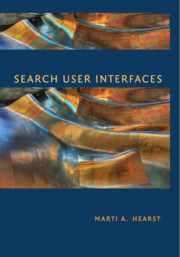Book contents
- Frontmatter
- Contents
- Preface
- 1 The Design of Search User Interfaces
- 2 The Evaluation of Search User Interfaces
- 3 Models of the Information Seeking Process
- 4 Query Specification
- 5 Presentation of Search Results
- 6 Query Reformulation
- 7 Supporting the Search Process
- 8 Integrating Navigation with Search
- 9 Personalization in Search
- 10 Information Visualization for Search Interfaces
- 11 Information Visualization for Text Analysis
- 12 Emerging Trends in Search Interfaces
- Appendix: Additional Copyright Notices
- Bibliography
- Index
- Author Index
- Plate section
2 - The Evaluation of Search User Interfaces
Published online by Cambridge University Press: 05 March 2013
- Frontmatter
- Contents
- Preface
- 1 The Design of Search User Interfaces
- 2 The Evaluation of Search User Interfaces
- 3 Models of the Information Seeking Process
- 4 Query Specification
- 5 Presentation of Search Results
- 6 Query Reformulation
- 7 Supporting the Search Process
- 8 Integrating Navigation with Search
- 9 Personalization in Search
- 10 Information Visualization for Search Interfaces
- 11 Information Visualization for Text Analysis
- 12 Emerging Trends in Search Interfaces
- Appendix: Additional Copyright Notices
- Bibliography
- Index
- Author Index
- Plate section
Summary
Throughout this book, the merits of an interface are assessed from a usability perspective; this chapter discusses how these assessments are done. It is surprisingly difficult to design a usable new search interface, and perhaps even harder to convincingly assess its usability (Draper and Dunlop 1997). An evaluator must take into account differences in designs, tasks, participant motivation, and knowledge, all of which can vary the outcome of a study. Furthermore, as mentioned in Chapter 1, small details in the design of the interface can have a strong effect on a participant's subjective reaction to or objective success with the interface. For instance, problematic placement of controls or unintuitive text on a hyperlink can prevent a participant from succeeding in a task. Differences in font contrast and spacing can unconsciously affect a participant's subjective response to a design.
What should be measured when assessing a search interface? Traditional information retrieval research focuses on evaluating the proportion of relevant documents retrieved in response to a query. In evaluating search user interfaces, this kind of measure can also be used, but is just one component within broader usability measures. Recall from Chapter 1 that usable interfaces are defined in terms of learnability, efficiency, memorability, error reduction, and user satisfaction (Nielsen 2003b; Shneiderman and Plaisant 2004).
Information
- Type
- Chapter
- Information
- Search User Interfaces , pp. 29 - 63Publisher: Cambridge University PressPrint publication year: 2009
Accessibility standard: Unknown
Why this information is here
This section outlines the accessibility features of this content - including support for screen readers, full keyboard navigation and high-contrast display options. This may not be relevant for you.Accessibility Information
- 1
- Cited by
